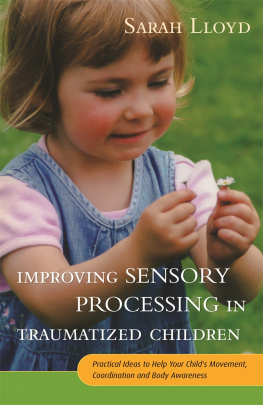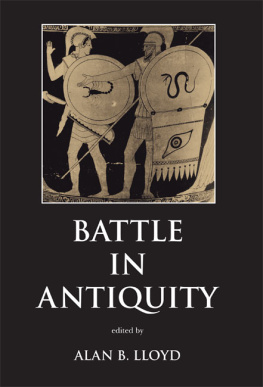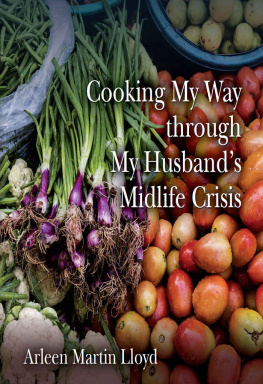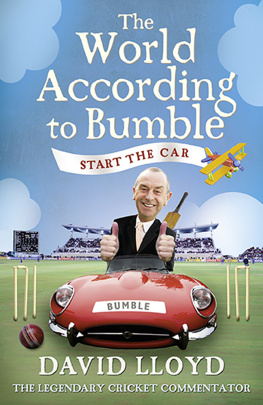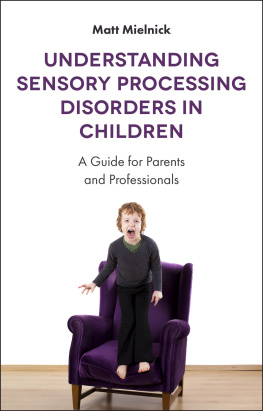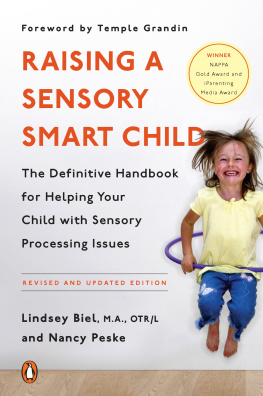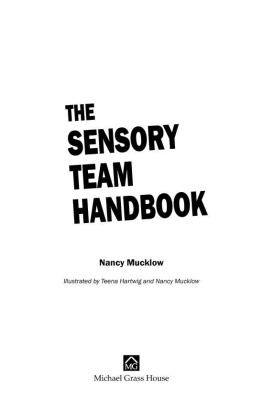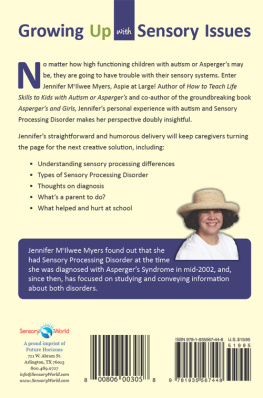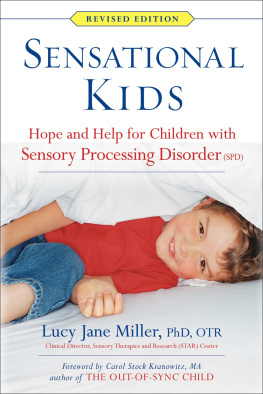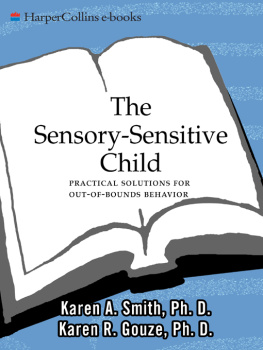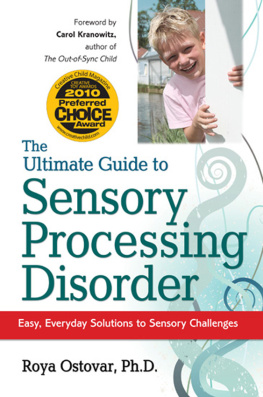Lloyd - Improving Sensory Processing in Traumatized Children
Here you can read online Lloyd - Improving Sensory Processing in Traumatized Children full text of the book (entire story) in english for free. Download pdf and epub, get meaning, cover and reviews about this ebook. year: 2015, publisher: Jessica Kingsley Publishers, genre: Home and family. Description of the work, (preface) as well as reviews are available. Best literature library LitArk.com created for fans of good reading and offers a wide selection of genres:
Romance novel
Science fiction
Adventure
Detective
Science
History
Home and family
Prose
Art
Politics
Computer
Non-fiction
Religion
Business
Children
Humor
Choose a favorite category and find really read worthwhile books. Enjoy immersion in the world of imagination, feel the emotions of the characters or learn something new for yourself, make an fascinating discovery.
- Book:Improving Sensory Processing in Traumatized Children
- Author:
- Publisher:Jessica Kingsley Publishers
- Genre:
- Year:2015
- Rating:5 / 5
- Favourites:Add to favourites
- Your mark:
- 100
- 1
- 2
- 3
- 4
- 5
Improving Sensory Processing in Traumatized Children: summary, description and annotation
We offer to read an annotation, description, summary or preface (depends on what the author of the book "Improving Sensory Processing in Traumatized Children" wrote himself). If you haven't found the necessary information about the book — write in the comments, we will try to find it.
Lloyd: author's other books
Who wrote Improving Sensory Processing in Traumatized Children? Find out the surname, the name of the author of the book and a list of all author's works by series.
Improving Sensory Processing in Traumatized Children — read online for free the complete book (whole text) full work
Below is the text of the book, divided by pages. System saving the place of the last page read, allows you to conveniently read the book "Improving Sensory Processing in Traumatized Children" online for free, without having to search again every time where you left off. Put a bookmark, and you can go to the page where you finished reading at any time.
Font size:
Interval:
Bookmark:

IMPROVING SENSORY PROCESSING
IN TRAUMATIZED CHILDREN
of related interest
Can I tell you about Sensory Processing Difficulties?
A guide for friends, family and professionals
Sue Allen
Illustrated by Mike Medaglia
ISBN 978 1 84905 640 3
eISBN 978 1 78450 137 2
The Pocket Occupational Therapist for Families
of Children With Special Needs
Cara Koscinski
ISBN 978 1 84905 932 9
eISBN 978 0 85700 721 6
Fuzzy Buzzy Groups for Children with Developmental
and Sensory Processing Difficulties
A Step-by-Step Resource
Fiona Brownlee and Lindsay Munro
Illustrated by Aisling Nolan
ISBN 978 1 84310 966 2
eISBN 978 0 85700 194 8
The Kids Guide to Staying Awesome and In Control
Simple Stuff to Help Children Regulate their Emotions and Senses
Lauren Brukner
ISBN 978 1 84905 997 8
eISBN 978 0 85700 962 3
Games and Activities for Attaching With Your Child
Deborah D. Gray and Megan Clarke
ISBN 978 1 84905 795 0
eISBN 978 1 78450 152 5
Promoting Attachment With a Wiggle, Giggle, Hug and Tickle
A Programme for Babies, Young Children and Carers
Fiona Brownlee and Lindsay Norris
ISBN 978 1 84905 656 4
eISBN 978 1 78450 149 5
Attaching Through Love, Hugs and Play
Simple Strategies to Help Build Connections with Your Child
Deborah D. Gray
ISBN 978 1 84905 939 8
eISBN 978 0 85700 753 7
IMPROVING SENSORY
PROCESSING IN
TRAUMATIZED CHILDREN
Practical Ideas to Help Your Childs Movement,
Co-ordination and Body Awareness
S ARAH L LOYD

Jessica Kingsley Publishers
London and Philadelphia
First published in 2016
by Jessica Kingsley Publishers
73 Collier Street
London N1 9BE, UK
and
400 Market Street, Suite 400
Philadelphia, PA 19106, USA
www.jkp.com
Copyright Sarah Lloyd 2016
Front cover image source: Ray Lloyd.
All rights reserved. No part of this publication may be reproduced in any material form (including photocopying or storing it in any medium by electronic means and whether or not transiently or incidentally to some other use of this publication) without the written permission of the copyright owner except in accordance with the provisions of the Copyright, Designs and Patents Act 1988 or under the terms of a licence issued by the Copyright Licensing Agency Ltd, Saffron House, 610 Kirby Street, London EC1N 8TS. Applications for the copyright owners written permission to reproduce any part of this publication should be addressed to the publisher.
Warning: The doing of an unauthorised act in relation to a copyright work may result in both a civil claim for damages and criminal prosecution.
Library of Congress Cataloging in Publication Data
Names: Lloyd, Sarah, 1967- author.
Title: Improving sensory processing in traumatized children : simple ideas to
help your childs movement, coordination and body awareness / Sarah Lloyd.
Description: London ; Philadelphia : Jessica Kingsley Publishers, 2016. |
Includes bibliographical references and index.
Identifiers: LCCN 2015027858 | ISBN 9781785920042 (alk. paper)
Subjects: LCSH: Abused children--Rehabilitation. | Sensory disorders in
children--Patients--Rehabilitation.
Classification: LCC RJ507.A29 L56 2016 | DDC 618.92/8--dc23 LC record available at
http://lccn.loc.gov/2015027858
British Library Cataloguing in Publication Data
A CIP catalogue record for this book is available from the British Library
ISBN 978 1 78592 004 2
eISBN 978 1 78450 239 3
CONTENTS
ACKNOWLEDGEMENTS
I am very grateful to the Springfield Project team for all its help and support in developing this work. Its a great team that is doing some really good work and I feel privileged to have been part of it. Also, a huge thank you to all the foster parents, adoptive parents, teachers, colleagues and friends who gave helpful feedback at various stages of the writing of this book and all the children who agreed to let me use their pictures. And last but not least, my family, for all their top tips, encouragement and support thank you!
INTRODUCTION
I started writing this book when I was working in Fife, Scotland, between 2005 and 2013 as part of the Springfield Project, a joint Child and Adolescent Mental Health Service and Social Work team looking at the therapeutic needs of children who are in foster and adoptive care.
This book is about sensory integration, one of the therapies that we found to be helpful for these children. Developed originally by Dr A Jean Ayres, an Occupational Therapist, it offers a way of understanding how early movement experiences affect brain development.
We found that some children who had missed out on early movement experiences werent able to do the more complicated things as they got older like recognize how theyre feeling on the inside.
We noticed a group of children who were so out of tune with themselves that they really struggled to manage to think about any sorts of feelings even things like if they felt hot or cold or whether they could make their hearts beat faster by running around. Foster carers often talked about children seeming to have no sense of whether they felt hungry or full and described having to stop the children eating when they judged that theyd had enough, otherwise they would keep on eating until they made themselves sick. While some of that may be about an emotional emptiness, the more we heard about it and the more we worked with these children, the more we realized that there was also a physical component to it they were dysregulated to the extent that they literally couldnt register how they felt on the inside. We realized that we needed to do something to address this before these children would be able to use psychological therapies to explore the emotional impact of their experiences.
While there are lots of good books around about sensory processing and sensory integration, we found that, because of the trauma these children had experienced, we couldnt just give teachers or parents activity ideas to do with children and let them get on with it.
These childrens early experiences mean that they react to things in different ways to other children. So while crawling through a tunnel into a snug den might be a fun adventure for one child, it might remind another of being trapped and unable to get away from someone who was hurting them.
We realized that we needed to do something to address this dysregulation before these children would be able to use psychological therapies to explore the emotional impact of their experiences. By combining sensory integration theory and a neurosequential understanding of trauma, we were able to understand the importance of movement in forming a foundation layer for social and emotional development.
While carrying out the work, we saw that good bodily awareness and functioning was really like the bottom layer of a tower of building blocks the stable base that allows the rest of the tower to be built on top of it. We found that by understanding which systems were not adequately primed (i.e. hadnt had enough stimulation to get them into good working order), we were able to develop games and activities that let parents and children go back and fill in some of those gaps. By doing so, children became much more aware of themselves and their bodies one teacher described the change as a child seeming much more comfortable in their own skin. Following this, we noticed that children were much more able to regulate themselves they stopped going too fast all the time and became able to stop and think sometimes. This leap in development made a huge difference to their everyday lives and gave us a platform to be able to help build relationships and learning.
Next pageFont size:
Interval:
Bookmark:
Similar books «Improving Sensory Processing in Traumatized Children»
Look at similar books to Improving Sensory Processing in Traumatized Children. We have selected literature similar in name and meaning in the hope of providing readers with more options to find new, interesting, not yet read works.
Discussion, reviews of the book Improving Sensory Processing in Traumatized Children and just readers' own opinions. Leave your comments, write what you think about the work, its meaning or the main characters. Specify what exactly you liked and what you didn't like, and why you think so.

